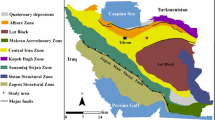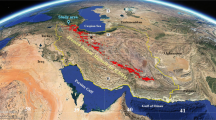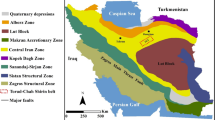Abstract
Machine Learning technologies have the potential to deliver new nonlinear mineral prospectivity mapping (MPM) models. In this study, Back Propagation (BP) neural network Support Vector Machine (SVM) methods were applied to MPM in the Hatu region of Xinjiang, northwestern China. First, a conceptual model of mineral prospectivity for Au deposits was constructed by analysis of geological background. Evidential layers were selected and transformed into a binary data format. Then, the processes of selecting samples and parameters were described. For the BP model, the parameters of the network were 9–10 − 1; for the SVM model, a radial basis function was selected as the kernel function with best C = 1 and γ = 0.25. MPM models using these parameters were constructed, and threshold values of prediction results were determined by the concentration-area (C-A) method. Finally, prediction results from the BP neural network and SVM model were compared with that of a conventional method that is the weight- of- evidence (W- of- E). The prospectivity efficacy was evaluated by traditional statistical analysis, prediction-area (P-A) plots, and the receiver operating characteristic (ROC) technique. Given the higher intersection position (74% of the known deposits were within 26% of the total area) and the larger AUC values (0.825), the result shows that the model built by the BP neural network algorithm has a relatively better prediction capability for MPM. The BP neural network algorithm applied in MPM can elucidate the next investigative steps in the study area.















Similar content being viewed by others
References
Abedi M, Norouzi GH (2012) Integration of various geophysical data with geological and geochemical data to determine additional drilling for copperexploration. J Appl Geophys 83:35–45
Abedi M, Torabi SA, Norouzi GH, Hamzeh M, Elyasi GR (2012a) PROMETHEEII: a knowledge-driven method for copper exploration. Comput Geosci 46:255–263
Abedi M, Torabi SA, Norouzi GH, Hamzeh M (2012b) ELECTRE III: a knowledgedriven method for integration of geophysical data with geological and geochemical data in mineral prospectivity mapping. J Appl Geophys 87:9–18
Abedi M, Norouzi GH, Fathianpour N (2013) Fuzzy outranking approach: a knowledge-driven method for mineral prospectivity mapping. Int J Appl Earth Obs Geoinf 21:556–567
Abedi M, Kashani SBM, Norouzi GH, Yousefi M (2017) A deposit scale mineral prospectivity analysis: a comparison of various knowledge-driven approaches for porphyry copper targeting in Seridune, Iran. J Afr Earth Sci 128:127–146
Agterberg FP (1971) A in the forward propagation process, index for detecting favourable geological environments. Can Inst Min Metall 10:82–91
Agterberg FP (1974) Automatic contouring of geological maps to detect target areas for mineral exploration. Math Geol 6:373–395
Agterberg FP, Bonham-Carter GF (1999) Logistic regression and weights of evidence modeling in mineral exploration, Proc.28th Int Symp app Comput mineral Ind (APCOM). Golden,CO, USA, pp 483–490
Atkinson P, Tatnall A (1997) Introduction neural networks in remote sensing. IntJ Remote Sens 18:699–709
Bonham-Carter GF (1994) Geographic information Systems for Geoscientists: modeling with GIS. Pergamon Press, Ontario, Canada 398
Bonham-Carter GF, Agterberg FP, Wright DF (1989) Weights of evidence modelling: a new approach to mapping mineralpotential, statistical applications in earth. Sciences 89(9):171–183
Bradley AP (1997) The use of the area under the ROC curve in the evaluation of machine learning algorithms. Pattern Recogn 30:1145–1159
Breiman L (2001) Randomforests. Mach. Learn 45:5–32
Brown WM, Gedeon TD, Groves DI, Barnes RG (2000) Artificial neural networks: a new method for mineral prospectivity mapping. Aust J Earth Sci 47:757–770
Burger H, Kirsch C, Skala W (1989). The application of microcomputers in exploration and exploitation of mineral deposits.Original Research Article Computers & Geosciences 15(4): 587–591
Carranza EJM (2008) Geochemical anomaly and mineral prospectivity mapping in GIS. In: Handbook of exploration and environmental geochemistry, vol 11. Elsevier, Amsterdam, p 351
Carranza EJM (2010) Improved wildcat modelling of mineral prospectivity. Resour Geol 60:129–149
Carranza EJM (2017) Natural resources research publications on geochemical anomaly and mineral potential mapping, and introduction to the special issue of papers in these fields. Nat Resour Res 26(4):379–410
Carranza EJM, Hale M (2001) Logistic regression for geologically constrained mapping of gold potential, Baguio district. Philipp. Explor Min Geol 10:165–175
Carranza EJM, Hale M (2002a) Wildcat mapping of gold potential, Baguio district,Philippines. Trans Inst Min Metall Appl Earth Sci 111:100–105
Carranza EJM, Hale M (2002b) Where porphyry copper deposits are spatially localized? A case study in Benguet province, Philippines. Nat Resour Res 11:45–59
Carranza EJM, Mangaoang JC, Hale M (1999) Application of mineral exploration models and GIS to generate mineral potential maps as input for optimum landuse planning in the Philippines. Nat Resour Res 8:165–173
Chen Y (2015) Mineral potential mapping with a restricted Boltzmann machine. Ore Geol Rev 71:749–760
Chen Y, Lu L, Li X (2014) Application of continuous restricted Boltzmann machine to identify multivariate geochemical anomaly. J Geochem Explor 140:56–63
Cheng Y, Wu W (2017) Mapping mineral prospectivity using an extreme learning machine regression. Ore Geol Rev 80:200–213
Cheng Q, Agterberg FP, Ballantyne SB (1994) The separation of geochemical anomalies from background by fractal methods. J Geochem Explor 51:109–130
Cheng Q, Chen ZJ, Khaled A (2007) Application of fuzzyweights of evidence methodin mineral resource assessmentfor gold in Zhenyuan District, Yunnan Province, China. Earth Sci J China Univ Geosci (In Chinese) 32:175–184
David BS, Paul KT, Shen SQ et al (1993) The Hatu gold anomaly, Xinjiang-Uygur autonomous region, China — testing the hypothesis of aeolian transport of gold. J Geochem Explor 47:201–216
Fawcett T (2006) An introduction to ROC analysis. Pattern Recogn Lett 27:861–874
Foody GM, Mathur A (2004) A relative evaluation of multiclass image classification by support vector machines. IEEE Trans Geosci Remote Sens 42(6):1335–1343
Gao Y, Zhang ZJ, Xiong YH, Zuo RG (2016) Mapping mineral prospectivity for cu polymetallic mineralization insouthwest Fujian Province, China .Ore Geol Rev 75 (2016) 16–28
Good IJ (1950) Probability and the weighting of evidence. Griffin, London 119pp
Hamid NA, Nawi NM, Ghazali R (2011) Accelerating Learning Performance of Back Propagation Algorithm by Using Adaptive Gain Together with Adaptive Momentum and Adaptive Learning Rate on Classification Problems Computing and Multimedia Applications. Second International Conference, UCMA 2011, Daejeon, Korea, April 13–15. Proceedings, Part II
Han BF, Qinq JJ, Sun B et al (2017) Late Paleozoic vertical growth of continental crust around the Junggar Basin, Xinjiang, China (Part I) : Timing of post-collisional plutonism. Acta Petrol Sin 2006 22(5):1077–1086 (in Chinese)
Harris DP (1965) An Application of Multivariate Statistical Analysis to Mineral Exploration
Harris DP (1969) Alaska’s base and precious metals resources: a probabilistic regional appraisal. Q. J. Colorado Sch. Min 64:295–327
Harris D, Pan G (1999) Mineral favorability mapping: a comparison of artificial neural networks, logistic regression, and discriminant analysis. Nat Resour Res 8:93–109
Hashemi Tangestani M, Moore F (2002) The use of Dempster-Shafer model andGIS in integration of geoscientific data for porphyry copper potential mapping,north of Shahr-e-Babak, Iran. Int J Appl Earth Observ Geoinform 4:65–74
Liu Y, Zhou KF, Xia QL (2017) A MaxEnt model for mineral Prospectivity mapping. Nat Resour Res. https://doi.org/10.1007/s11053-017-9355-2
Ma D, Zhou T, Chen J et al (2017) Supercritical water heat transfer coefficient prediction analysis based on BP neural network. Nucl Eng Des 320:400–408
Mejía-Herrera P, Royer JJ, Caumon G, Cheilletz A (2015) Curvature attribute from surface-restoration as predictor variable in Kupferschiefer copper potentials: an example from the fore-Sudetic region. Nat Resour Res 24(3):275–290
Molan YE, Behnia P (2013) Prospectivity mapping of Pb–Zn SEDEXmineralization using remote-sensing data inthe Behabad area, Central Iran. Int J Remote Sens 34(4):1164–1179
Moon WM (1990) Integration of geophysical and geological data using evidential belief function. IEEE Trans Geosci Remote Sens 28:711–720
Najafi A, Karimpour MH, Ghaderi M (2014) Application of fuzzy AHP method to IOCG prospectivity mapping Acase study in Taherabad prospecting area, eastern Iran. Int J Appl Earth Obs Geoinf 33:142–154
Nykänen V, Lahti I, Niiranen T, Korhonen K (2015) Receiver operating characteristics (ROC) as validation tool for prospectivity models — a magmatic Ni–cu case study from the Central Lapland Greenstone Belt, northern Finland. Ore Geol Rev 71:853–860
Oh H, Lee S (2010) Application of artificial neural network for gold-silver deposits potential mapping: a case study of Korea. Nat Resour Res 19:103–124
Oommen T, Misra D, Twarakavi NKC et al (2008) An objective analysis of support vector machine based classification for remote sensing. Math Geosci 40:409–422
Piccini C, Marchetti A, Farina R, Francaviglia R (2012) Application of indicator kriging to evaluate the probability of exceeding nitrate contamination thresholds. Int J Environ Res 6(4):853–862
Porwal A, Carranza EJM, Hale M (2006) Bayesian network classifiers formineral potential mapping. Comput Geosci 32(1):1–16
Rodriguez-Galiano V, Sanchez-Castillo M, Chica-Olmo M et al (2014) Machine learning predictive models for mineral prospectivity: Anevaluation of neural networks, random forest, regression trees and support vector machines. Ore Geol Rev 71:804–818
Sadeghi B, Khalajmasoumi M (2015) A futuristic review for evaluation of geothermal potentials using fuzzy logic and binary index overlay in GIS environment. Renew Sust Energ Rev 43:818–831
Shen P, Shen YC, Liu TB et al (2009) Geochemical signature of porphyries in the Baogutu porphyry copper belt, western Junggar, NW China. Gondwana Res 16(2):227–242
Shen P, Pan HD, Zhu HP (2016) Two fluid sources and genetic implications for the Hatu gold deposit, Xinjiang, China. Ore Geol Rev 73(2):298–312
Sinclair AJ, Woodsworth GL (1970) Multiple regression as a method of estimating exploration potential in an area near terrace, B.C. Econ Geol 65:998–1003
Smola AJ, Schölkopf B (2004) A tutorial on support vector regression. Stat Comput 14(3):199–222
Wang L, Zhu YF (2015) Multi-stage pyrite and hydrothermal mineral assemblage of the Hatu gold district (west Junggar, Xinjiang, NW China): implications for metallogenic evolution. Ore Geol Rev 69:243–267
Xu YJ, You T, Cl D (2015) An integrated micromechanical model and BP neural network for predicting elastic modulus of 3-D multi-phase and multi-layer braided composite. Compos Struct 122:308–315
Yin LB, Liu GC, Zhou JL et al (2017) A calculation method for CO2 emission in utility boilers based on BP neural network and carbon balance. Energy Procedia 105:3173–3178
Yousefi M, Kamkar-Rouhani A, Carranza EJM (2012) Geochemical mineralization probability index(GMPI):a new approach to generateen hanced stream sediment geochemical evidential map for increasing probability of success in mineral potential mapping. J Geochem Explor 115:24–35
Yousefi M, Carranza EJM, Kamkar-Rouhani A (2013) Weighteddrainagecatchment basin mapping of stream sediment geochemical anomalies for mineral potential mapping. J Geochem Explor 128:88–96
Yule GU (1912) On the methods of measuring association between two attributes. J.R. Stat. Soc 75:579–642
Zhang NN, Zhou KF (2015) Mineral prospectivity mapping with weights of evidence and fuzzy logic methods. J Intell Fuzzy Syst 29:2639–2651
Zhao ZH, Bai ZH, Xiao XL, Mei HJ (2006) The diagenetic and mineralization of the rich alkali igneous rocks in northern China. Xinjiang Geological Press, Beijing 2006:1–302 (in Chinese)
Zuo RG, Carranza EJM (2011) Support vector machine: a tool for mapping mineral prospectivity. Comput Geosci 37:1967–1975
Zuo R, Wang J (2016) Fractal/multifractal modeling of geochemical data: a review. J Geochem Explor 164:33–41
Zuo R, Zhang ZJ, Zhang DJ et al (2014) Evaluation of uncertainty in mineral prospectivity mapping due to missing evidence: a case study with skarn-type Fe deposits in southwestern Fujian Province, China. Ore Geol Rev 71:502–515
Acknowledgements
This work was supported by the National Natural Science Foundation of China (Grant No. 41602339, U1503291), the Western Light Foundation of the Chinese Academy of Sciences (CAS; Grant No. XBBS-2014-19), the Xinjiang Uygur Autonomous Major Project (Grant No. 201330121-3), the National Basic Research Program of China (Grant No. 973Program2014CB440803) and the Strategic Priority Research Program of the Chinese Academy of Sciences(XDA19030204).
Author information
Authors and Affiliations
Corresponding author
Additional information
Communicated by: H. A. Babaie
Rights and permissions
About this article
Cite this article
Zhang, N., Zhou, K. & Li, D. Back-propagation neural network and support vector machines for gold mineral prospectivity mapping in the Hatu region, Xinjiang, China. Earth Sci Inform 11, 553–566 (2018). https://doi.org/10.1007/s12145-018-0346-6
Received:
Accepted:
Published:
Issue Date:
DOI: https://doi.org/10.1007/s12145-018-0346-6




